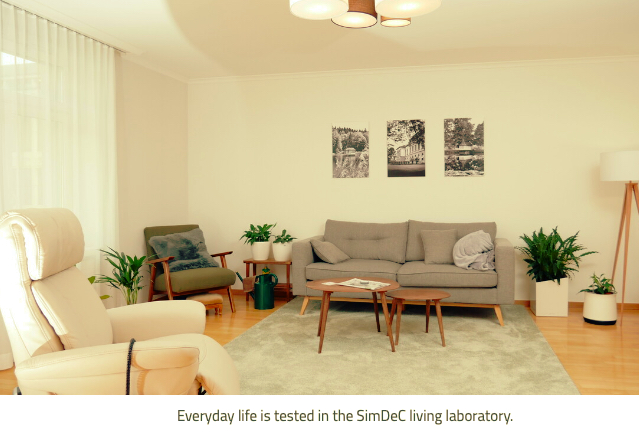
Living at home as independently as possible for as long as possible – this is the wish of many Swiss people. In view of the challenges of demographic change, this is currently also a goal of Swiss old-age policy. The innovative living laboratory “SimDeC” of the OST – Ostschweizer Fachhochschule uses a participatory approach to provide insights and impulses for the use of technology that can enable people to grow older in their own four walls.
Everyday life is tested in the SimDeC living laboratory.
Marlies* has always liked to wear blouses. She loved how she looked in them and the way they made her feel. A world collapsed for her when one day she could no longer button her blouse herself. Triggered by chemotherapy, Marlies suffered from sensory disorders that made buttoning impossible. Her frustration became so great that she threw away all her blouses. Years later, Marlies got to know an object that made it easy to fasten buttons again. This so-called “button aid” is not an expensive technical device, but is available in medical supply stores for as little as 20 Swiss francs. If Marlies had known about it, she would have been spared a lot of grief.
Solve everyday problems with simple technology
“If you don’t know that there is a solution, you come to terms with the problem,” says Josef Huber, explaining Marlies’ situation. He is the head of the SimDeC (simulation in the field of dementia care) and lecturer in the CAS life-world-oriented dementia care at the OST – Ostschweizer Fachhochschule. “There is an unbelievable variety and multitude of technical solutions that could make a decisive contribution to enabling people to grow older in their own four walls,” explains the expert. This is relevant insofar as the desire to grow old at home initially fails due to everyday phenomena. “How long someone can live at home is gradually decided in everyday life. Bottles are too difficult to open, the pepper mill is painful to touch, or products and groceries are packaged in a challenging manner. Emergencies such as falls or the worries of relatives tend to be among the late, acute reasons that people need a new living situation,” explains Josef Huber.
Josef Huber from the SimDeC residential laboratory tells of another example: “One person was with us who, due to dementia, could no longer recognize the silver cutlery. This was not due to an optical disturbance, but to recognition problems. » Josef Huber knows from experience that people with dementia are particularly good at recognizing the color red. “A cutlery with red handles was the solution – 14 months of autonomy gave it not only to the person concerned, but also to their relatives.” Most of those affected do not know simple solutions like these. That hardly surprises Josef Huber: «In our society there is a structural problem that knowledge about technology is not shared with those affected. Sometimes both those affected and their families lack the strength and time to search for solutions.» As a participatory innovation center, the SimDeC of the OST offers support for precisely these challenges.
Visiting the living laboratory SimDeC
Try it out, touch it, reflect – that’s what SimDeC is all about. “In the rented apartment, which is full of technical equipment, we sit at a table with representatives of the population and discuss wishes, expectations and fears on the topics of housing, technology and dementia,” says Josef Huber, describing the living laboratory. The aim is to record improvement requests for products and to get to know the needs better. Municipalities, cities, hospitals, affected persons and also relatives contact the SimDeC with inquiries. «If a problem is brought to our attention, we make an up-to-date overview of the market and together we develop a decision that is technically and ethically considered and based on criteria.»
Blue boxes full of solutions
In this area, research is primarily carried out on individual, concrete problems in the population. A variety of biographies and perspectives plays an important role for Josef Huber. “It is important to find tailor-made solutions for individual cases,” emphasizes the specialist in the field of care and technology. Based on such cases, the SimDeC bundles different solutions in blue boxes. “For example, one box is full of different bottle openers, in one we have voice emergency call devices and another is filled with eye drop application aids.” These boxes are then sent from location to location, for example to the Pro Senectute or to neighborhood associations. «Based on a concrete story and the appropriate solutions, we inform people about the technologies with as little stigma as possible. As researchers, we in turn learn from the queries.”
Source: OST, Aug 9, 2023
